Review for Nichijou - My Ordinary Life Collection 2
Introduction
Warnings are everywhere. It’s comforting that so many organisations and authorities assume that we are idiots, feel the need to protect us from ourselves and our environment, should the worst happen and someone gets sued. Packets of peanuts ‘may contain nuts’, news reports may contain flashing images, and I’m advised to keep my boxer shorts away from naked flames, and any urge I might have to place my head in a plastic bag is negated by the appropriate government health warning printed on each one. I feel so reassured that my best interests are taken care of in this way. Yet no one ever puts a health warning on a comedy. No one warns of the dangers of excessive mirth and merriment. Nichijou really should come with a ‘beverage out of the nostrils’ warning, as I found to my regret and embarrassment when sipping from a milkshake while watching the show.
Nichijou is really a sketch show, which makes putting a series synopsis together a little pointless. It might be more appropriate to concentrate on the characters, but Nichijou also has an embarrassment of riches here, so describing most of its characters would be prohibitive. For the first half of the series, there were two main areas of focus, the high school, and the Shinonome Laboratory. The Shinonome Laboratory is home to the Professor, a genius inventor and scientist who also happens to be a little girl, practically an infant. She’s had to invent her own caregiver, a perfectly human looking android named Nano, except for the clockwork key on her back. Nano wants to a normal girl, but the professor keeps adding optional extras to her design. Like all girls, Nano loves cute things, especially the Professor, but she also picks up a cute cat and brings it home. They name it Sakamoto, and the Professor promptly invents a scarf that allows the cute little kitty to speak. The cat turns out to be a middle aged male, who realising he’s the oldest in the Laboratory goes about demanding some respect for his authority. He’s Mr Sakamoto, and don’t you forget it.
Meanwhile school focuses on the lives of three friends, Yukko, Mio and Mai. Yukko is the happy go lucky, not altogether smart, but always coming up with wacky ideas member of the group. She’ll also go out of her way to infuriate Mio in some way, but she’ll hit a brick wall when she tries it with Mai. Mio tries to be strait-laced most of the time, but she has an explosive and violent temper that Yukko frequently provokes, and she also likes drawing the kind of manga that she’d rather not share with the class. Mai on the other hand has a propensity for surreal behaviour which is tailored to blow Yukko’s mind, and a discreet streak of sadism hidden behind a quiet and reserved demeanour. There are plenty of other colourful characters in this school, Mio has a crush on Sasahara, a boy who comes from a family of farmers, but considers himself an aristocrat, has a personal servant to attend to his every need, and rides a goat to school every day. He has another relationship with his class representative Misato Tachibana, the ultimate in tsundere who deals with her conflicted feelings for Sasahara by shooting him with various grades of military artillery when he infuriates her. In the second half of the series, everything changes when Nano starts going to school. The world of high school and the world of the Shinonome Laboratory meet, and suddenly everyday life is a whole lot more interesting.
The concluding thirteen episodes of Nichijou are presented across two discs from Madman Entertainment, seven on disc 1, six plus extras on disc 2.
Picture
Nichijou gets a 1.78:1 anamorphic transfer on these discs. It’s a native PAL conversion, so expect the 4% PAL speed up. The image is clear and sharp throughout, with strong and consistent colour reproduction. Clarity is excellent, there’s no sign of any compression artefacts, except maybe if you pause the discs during moments of frenetic motion on screen, and aliasing was minimal. You’ll have to look for it, but there is a smidge of edge-enhancement that becomes apparent when the show is up-scaled to an HD panel.
Based on a gag manga, the character designs in the show are a little more simplistic, while the colour palette is bright and chirpy without getting garish. There’s also a simplicity in the world design, but there is always significant production value and a level of detail beyond that required for a simple set-up punchline format. The animation is of consistently high quality throughout, fluid and detailed beyond that which you would expect from the artwork style. It’s a show that looks surprisingly good given its genre and it’s consistently pleasing to watch. I really like the segues between scenes, little vignettes of normality shown slightly out of focus.
Sound
Nichijou gets a DD 2.0 Japanese track, with optional translated English subtitles. Be aware that there isn’t an English dub for this show. I have no problems with the audio, the dialogue is clear and audible throughout, there are no problems with glitches or distortion, and the show’s action sequences and music come across with impact. The theme tunes are perfectly suited to the show, quirky and whimsical, while the show’s incidental music gets the orchestral treatment, really well defined musical pieces that almost seem like overkill for the show, but really do help make the material shine. PAL speedup is applied of course, but thankfully I could find no indication of pitch correction (It takes me a few seconds to get used to higher pitched audio, but I can never get used to the clipping and distortion of unsympathetically applied pitch correction).
Once more for the subtitles, it appears to me that Madman Entertainment merely used the Crunchyroll subtitle script without revision, simply retiming it to the PAL playback. In this collection though, there are no problems regarding missing subtitle captions and perhaps the only bugbear would be the absence of translations for the theme songs. Otherwise the subtitles are accurately timed and free of typographical error.
Extras
You get two discs in an Amaray style case, with one disc held on a central hinged panel, and one at the back. The inner sleeve artwork is a bit of a bonus that’s really nice to look at.
The discs present their content with static menus, and they have jacket pictures that you can see on compatible players when they aren’t spinning.
All of the extras are on disc 2, and unfortunately none of them have subtitles, which make them idle curiosities at best for non-Japanese speakers.
You get six minutes worth of alternate episode previews.
You get the second textless opening sequence (no problem with sound sync this time, and you get all of the textless closing sequences, 13 of them running to a total of 19 minutes. You can Play All or select which one you wish to watch. The animation is largely the same, but each episode gets a different ending theme song.
Following an Australian anti-piracy thank you, you get trailers for other Madman titles like Cardcaptor Sakura (Uncut) Collection 1, Summer Wars, Bamboo Blade Part 1, and Buso Renkin Series. The latter three are available in the UK as well, thanks to Manga Entertainment.
Conclusion
Nichijou Part 2 is hilarious. It’s the best anime comedy I have, a brilliant sketch show that had me out of breath laughing with each new episode. Its thirteen episodes just keep hitting the mark again and again, each sketch perfectly written, with impeccable timing and a left field, surreal sense of humour that seems like it was tailor-made for my tastes. Of course it’s still a sketch show, and it carries on from where Part 1 left off, and not every sketch will hit the mark in exactly the same way. But whereas in Part 1, the ratio of hits to misses was something like 8 in 10, in Part 2, it’s just the odd bit of comedy that goes over my head, and once again it’s probably the Helvetica Standard bits. Everything else just seems to work, and this time it’s working on a wholly different level than the comedy in Part 1.
It is very much the same show though, so I spent a little thought on why it was so much better, and the answer comes from the final episode of Part 1, where Nano starts going to school. That signals the biggest change in Nichijou. In the first 12 episodes, each joke was pretty much a standalone. That half of the series was about introducing the characters, and exploring their personal worlds. It was a little limiting in scope, and it was certainly limiting in the jokes that could be told. But once Nano started going to school, it allowed the world of the high school, and the world of the Shinonome Laboratory to combine and explore new avenues of humour. And the rest of Nichijou in Part 2 emulates this synergy. In this half, all of the little sketches, all the characters start interacting a lot more, the running jokes get more elaborate, and the resulting mix and match of comedy is unpredictable, creative and wholly entertaining.
There is actually one Helvetica Standard gag that made me laugh in this collection, just for that reason. The Igo Soccer club made little sense in the first half, but it delivers on the comedy in this collection of episodes when an actual Igo Soccer player joins the club, revealing it to be a genuine sport. Now that the club is going places, they need a teacher to supervise; only the likeliest candidate is reluctant. But he’s got a crush on fellow teacher Sakurai, and when it’s her kid brother who’s the new star Igo Soccer player, the spectre of blackmail arises. Indeed, in amongst all the sketches, all the random bits of comedy, you can see threads of narrative start to develop in Nichijou’s second half, and not just in the Igo Soccer Club.
It still hits all the comedy genres from surreal to slapstick, from cerebral to lowbrow, and even more than before, there’s something for everyone here. One of my favourite bits, out of a plethora of favourite bits, is an actual anime silent comedy, a short sketch that put me in mind of the short film The Plank. In this sketch, Mio and Yukko are killing time, building a house of cards; only the challenges to the stability of their construction are far more than just a draughty door.
The characters are still amazing, whether it’s Mai’s surreal sense of humour (Asymmetry), or Yukko’s daft boneheaded-ness (coffee shop menu panic), or it’s Mio’s explosive temper. She is the anime equivalent of James Finlayson when it comes to the slow burn, but when she lets loose her aggravation, it reaches epic proportions, such as her rant when Yukko decides to ‘help’ with her manga.
That’s the problem with sketch comedy like this. When it comes to reviewing it, it’s easy for the whole process to become a listing of the best bits, and I could go on for hours doing that. I’d much rather just watch it all over again. Part 1 had a few issues, but it was really just the build up for this part 2, where all the pieces fall into place, and create the best anime comedy that I have in my collection. Nichijou is hilarious, and I urge you to watch it on Crunchyroll, catch a few clips on YouTube, buy the DVDs, and then watch it all over again.
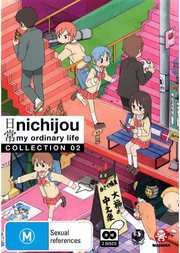
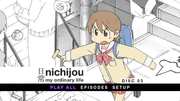

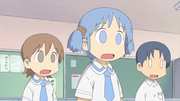
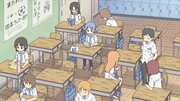
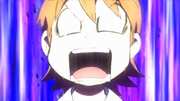


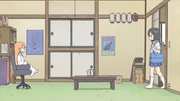
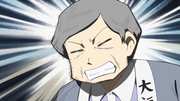
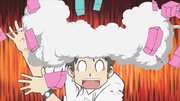
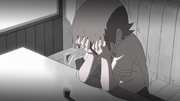




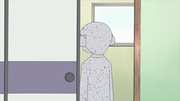
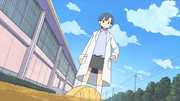

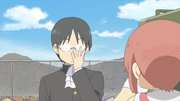
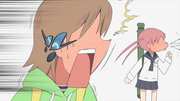


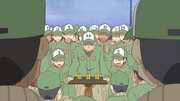
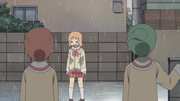

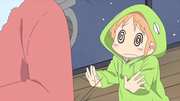

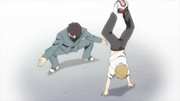
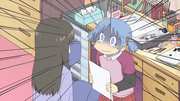
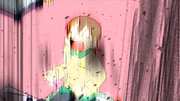































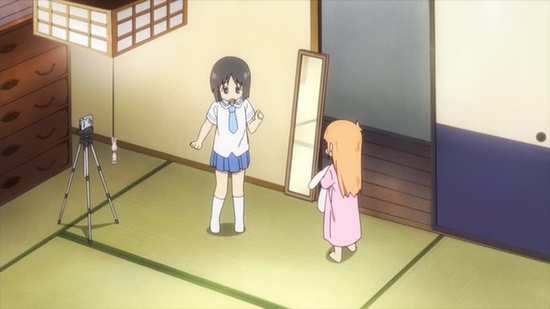










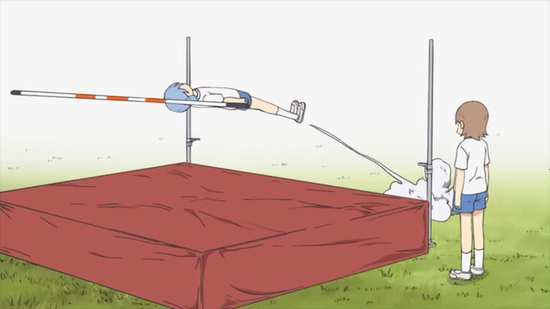
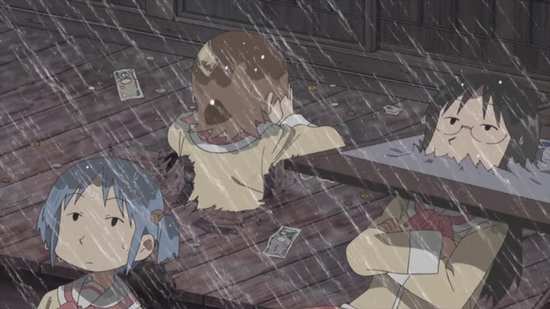


Your Opinions and Comments
Be the first to post a comment!